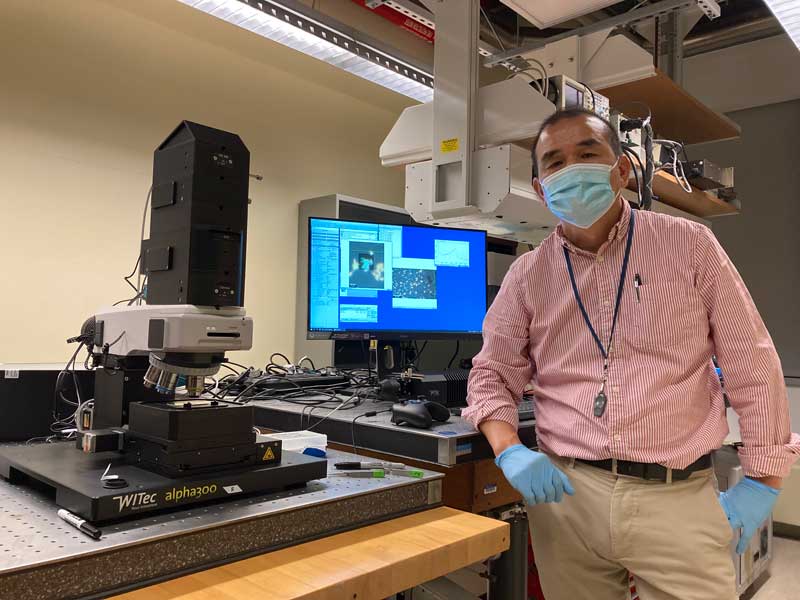
Chemistry professor Kazushige Yokoyama with Geneseo’s NSF grant-funded Raman imaging system. (Photo provided)
SUNY Geneseo has received an award of $210,132 from the National Science Foundation’s Major Research Instrumentation program for the chemistry department to purchase a three-dimensional Raman imaging system. The powerful and complex laser-based microscopic device—seldom accessible to undergraduate students—will be available to Geneseo students across multiple disciplines, through research projects in chemistry, biology, geological sciences, and anthropology.
Undergraduate researchers will use the instrument in six collaborative interdisciplinary research projects at Geneseo:
• Kazushige Yokoyama, professor of chemistry and principal investigator for the NSF grant, will examine proteins associated with plaques that are known components of neurodegenerative diseases like Alzheimer’s and Parkinson’s. His work has the potential to be applied to any proteins located over a spherical shape, including the spike proteins observed in the novel coronavirus.
• James Aimers, professor of anthropology, will investigate the composition of ancient Mayan pottery found in Central and South America.
• Dori Farthing, associate professor and chair of geological sciences, will characterize the devitrification process in metallurgical slag, helping us understand the potential environmental impacts of slag disposal.
• Jani Lewis, associate professor of biology, will identify three morphologically similar but chemically different proteins at a cellular junction that will aid in the diagnosis of different types of cancer.
• Nicholas Warner, associate professor of geological sciences, will characterize Mars analog materials to better understand the role of water in shaping the landscape, with implications for past habitability.
“Our main goal is for Geneseo students to develop skills with top-notch instrumentation,” says Yokoyama. “This system will inspire them to be creative, help them learn to problem-solve, and serve as a passport to higher-level research collaboration with PhD institutions.”
The imaging system uses scattered light to detect the chemical structure of materials at a nanoscopic level, or less than 1/100th of the width of a human hair. The Raman images it creates let researchers identify a sample’s chemical composition and characterize its molecular-level interactions.
The system is particularly useful for teaching undergraduates, explains Yokoyama, due to its compact, tabletop size and reliable ability to produce repeatable results.
“This state-of-the-art instrument will support collaborative efforts, mentoring opportunities, and hands-on undergraduate research training,” says Jeffrey Peterson, associate professor and chair of the chemistry department.
Read more about undergraduate research in the chemistry department.
